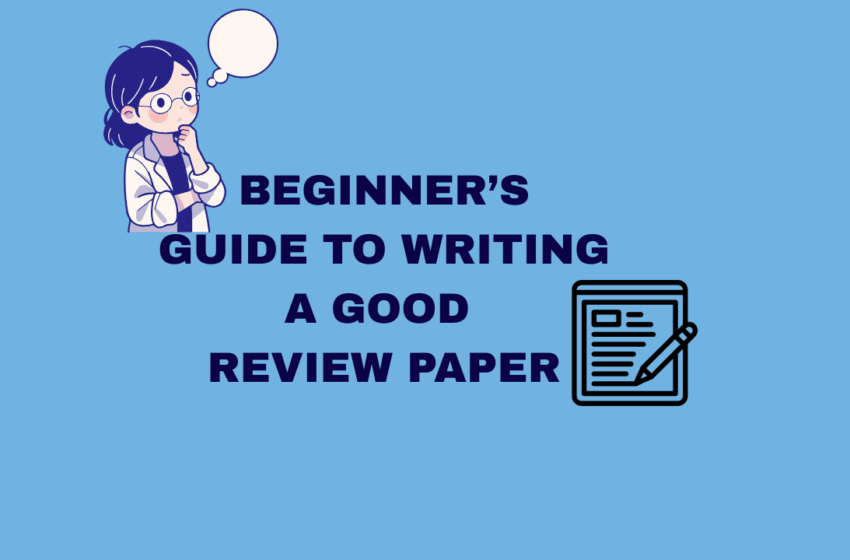How to Write a Technical Review Paper: A Guide for New Researchers

Writing a technical review paper is one of the most challenging tasks in a researcher’s academic journey. Many researchers are not trained on conducting technical reviews, and hence end up discontinuing the task midway because of the extensive work involved in it.
This blog will help you understand the process of conducting a technical review and explain how writing a review paper can be simplified by adequate planning and organization.
What Makes a Review Paper Effective
What is a Technical Review?
A technical review is essentially an in-depth investigation of existing published literature on a specific topic. The intention of a review paper is to summarize information in a way that provides new insights to help advance research in the right direction.
With over 5 million research papers published annually1, it is critical for scientists to know what their next area of focus should be. Technical reviews play a crucial role in guiding researchers in this aspect. A technical review dives into a specific field or a research topic to summarize the current knowledge. The insights extracted help identify gaps in existing literature, offering suggestions for future research directions.
Examples of review papers: Check out this list of review papers published in IEEE Sensors journal2.
Types of Review Papers
Review papers can be of different types. The 4 most common review papers include the narrative review, integrative review, scoping review, and systematic review.
1. Narrative Review
- A narrative review provides a comprehensive analysis of existing knowledge on a research topic or a field of study, covering a broad scope.
- It typically surveys the published literature and focuses on a theory or a methodology to summarize the information previously reported.
- The review is written in a narrative format, often following the IMRaD (Introduction, Methods, Results, and Discussion) structure.
- These reviews are useful for exploring debates on a research topic, appraising previous studies, identifying knowledge gaps, and examining state-of-the-art methodologies.
2. Integrative Review
- Integrative reviews lay the foundation for developing a new perspective on a research topic by synthesizing information from existing literature.
- Researchers examine multiple sources or databases to observe patterns and obtain a strong understanding of existing knowledge by comparing reports and findings. They develop a new argument or offer novel insights based on this comparison.
- This type of review uses both qualitative and quantitative methodologies, covering the experimental as well as theoretical aspects depending on the field of study.
- Integrative reviews are often used for advancing nursing science, developing clinical practices, and improving the implementation of policy actions.
3. Scoping Review
- Scoping reviews are used for mapping existing evidence on a topic of study, focusing on the breadth of the research rather than diving deep into it.
- The objective of conducting a scoping review is to identify the main concepts and theories to recognize which knowledge gaps need addressing in future studies.
- In a way, scoping reviews pave the way for systematic reviews, especially in the healthcare industry by guiding practitioners and policymakers.
4. Systematic Review
- A systematic review is perhaps the most comprehensive type of review, wherein a specific research question is systematically answered.
- The primary purpose of systematic reviews is to minimize bias by employing explicit methods to collect all evidence before forming an opinion.
- Systematic reviews are executed by following clear guidelines or protocols, such as the PRISMA3 (Preferred Reporting Items for Systematic reviews and Meta Analyses) checklist.
Each of the above type of technical review serves a different purpose. But the common factor is that all technical reviews guide researchers in advancing scientific knowledge. Are there any other benefits though? In one word, yes!
Why Technical Reviews Matter
From an author’s perspective, any scholarly publishing should aid in expanding their knowledge base while simultaneously advancing their career. Technical reviews do exactly that!
- Because technical reviews require you to dive deep into the literature and synthesize information after a comprehensive comparison, it helps hone your reviewing skills. This can help you even when you write regular research papers as a literature search is necessary in that case too.
- Moreover, the insights gained must be presented in a way that captures the attention of a wide audience, not limited to experts in your field. In other words, you learn how to collate relevant information filtered from a vast collection of sources, understand the highlights of the research topic, focus on one area that shows promise, and then interpret the insights in a way that eases comprehension for your readers.
- Technical reviews are a great way to increase your recognition in the scholarly community because well-written review papers receive more citations than regular research papers. Unlike a normal study, technical reviews cover vast literature, making them a source that provides a wealth of knowledge in one place.
- Finally, keep in mind that technical reviews do not warrant too many resources. All you need is access to published literature and a good research topic that is worth exploring.
What Makes a Review Paper Effective
It is quite clear that authors can benefit from writing review papers. However, the scholarly community may criticize technical reviews that do not actually contribute to the development of scientific knowledge. So, what exactly makes a review paper “good”? Here are 7 key elements to consider.
1. Novelty of the topic
In any research field, the topic selected must be important and new. There is no point in writing about something that has already been investigated in depth. See what has already been published and look for research areas that remain unexplored.
For instance, this review paper4 consolidates and evaluates existing machine learning (ML) algorithms and sensor technologies that are used in wireless sensor networks to improve their applications in monitoring systems for the elderly. Considering the rapid increase in the global elderly population, the authors identified that smart monitoring solutions can have great potential in the future. This makes the topic crucial and novel, contributing to the development of user-friendly aging-in-place systems.
2. The central theme of the review
A good review focuses on a specific theme after a thorough literature search. For instance, when you begin browsing the literature for applications of ML algorithms, you are likely to find that there are many research opportunities. But how to you recognize the topic most suited for a technical review? You can start by listing applications that are likely to have the highest impact. This list can be further shortened by reading existing literature and identifying where there is a research gap. Your technical review can then focus on highlighting the limitations of existing ML or AI solutions and recommend future directions of research.
3. Beyond literature lists
A good review paper does more than simply list studies from the literature. When journal editors, reviewers, or even readers come across a review paper, they are expecting to learn what the future holds in that field of study. So, the author’s responsibility is to consolidate and integrate information to extract insights to guide the audience.
4. Structure and flow
Like any other academic paper, a review paper must be logically structured. Typically, review papers are lengthier than regular research papers. So the outline must be more than just the basic IMRaD structure. The main headings of the sections can remain the same as IMRaD, especially in the case of narrative reviews. However, in general, all review papers must first provide a concise overview of the topic in question and then lead to the specifics. This means that there should be sub-sections that focus on different aspects that are relevant to your technical review. And each sub-section should explore a sub-topic or a sub-theme that builds understanding of the central theme of the paper.
5. Write what’s necessary
Although review papers tend to be lengthy, they should not overwhelm the readers with unnecessary information. A typical word count for a review paper can range from 3,000 to 5,000 words. However, this limit varies depending on the journal, the research field, and the topic of review. Some journals may even allow up to 8,000 or 10,000 words. So always read the journal guidelines before preparing the review paper. As a rule, keep in mind that there should be sufficient detail for readers to understand the context of the review.
- What was the reason for you to choose the topic?
- Which research area do you intend to address?
- How is your review different from prior reviews?
Make sure these questions are answered. However, do not dwell on explaining all the details of previously reported studies. Instead, highlight the key points and provide your interpretation of the insights as a summary.
6. Write for a broad readership
Technical reviews are always written for a wide audience and not just for experts familiar with the research topic. For instance, let’s take the example of the review paper mentioned above4.
It will not just be researchers exploring AI and ML applications that will be keen on understanding what the future holds. People caring for elderly patients or policymakers working on improving senior care will also be interested to know how AI is contributing to aging-in-place systems. Even healthcare experts will be curious about intelligent monitoring solutions that can ensure an independent life to their elderly patients.
So, the review paper must be authored with this broad scope of audience in mind. While technical jargon must be used to provide context and clarity, the implications and impact must be presented in a way that’s easily comprehensible to non-experts.
7. Maintain a visual appeal
Review papers may not use as many figures or graphical representations as regular papers. However, using visual aids such as illustrations, photographs, diagrams, or graphics can help readers understand concepts better. If there are experimental processes being described or if relationships between multiple variables are being explained, depict them visually for simplification. Create a good balance between visual aids and text in the paper to provide a holistic reading experience to the readers.
References
1. Number of academic papers published per year https://wordsrated.com/number-of-academic-papers-published-per-year/
2. List of review papershttps://ieee-sensors.org/review-papers/
3. PRISMA guidelineshttps://www.prisma-statement.org/prisma-2020-checklist/
4. Machine Learning Algorithms and Sensor Technologies for Aging-In-Place Applications: A Review https://ieeexplore.ieee.org/document/11099603







